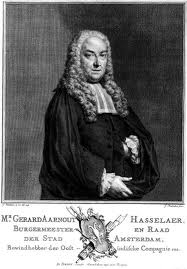Gerard Arnout Hasselaer
Gerard Arnout Hasselaer (20 February 1698, Amsterdam - 12 July 1766, Heemstede) was a burgomaster and counsellor of the city of Amsterdam, and a Director of the Dutch East India Company.[1]
Gerard Arnout Hasselaer | |
|---|---|
 | |
| Born | 1698 |
| Died | 1766 |
| Nationality | Netherlands |
| Known for | Director of the Dutch East India Company |
Some historians have said he was an able regent. Others have said he was conservative and not truly capable. A contemporary, Gijsbert Jan van Hardenbroek, said he was "idle and preoccupied with his own pleasures."[2] On 18 October 1748 Hasselaer was among the High and Mighty Lords of the States General of the United Provinces who were signatories to the Treaty of Aix-la-Chapelle (1748) which ended the War of the Austrian Succession.[3] Hasselaer was a director of the Indian Council when, in December 1748, Joan Gideon Loten obtained a position as a Councillor extraordinary.[4]
Hasselaer took an interest in navigation, and possessed a collection of scientific instruments.[2] He represented William IV, Prince of Orange in three Dutch Admiralties. At this time the Dutch were trying to catch up with the English in navigational knowledge and skills, and Hasselaer assisted in this process.[5] On his death Hasselaer left a collection of 266 objects, including navigational instruments. In November 1776 Utrecht University acquired an "extra fine octant in its case" made by Jonathan Sisson (c.1690-1747), a London-based maker of scientific instruments, from this collection.[6] Hasselaer, as regent of Amsterdam, was in contact with Sisson and with his Amsterdam-based brother-in-law Benjamin Ayres, also an instrument maker.[7]
Bibliography
Inventories of Hasselaer's collection and his library were published for the auction of 1776.
- Hasselaer, Gerard Arnout (1776). Catalogus van eene zeer schoone verzameling van natuurkundige instrumenten ... nagelaten door Mr. G. A. Hasselaer, welke zullen verkogt worden... den 22 november 1776 door H. van Otterloo en J. van Schoonhoven. H. van Otterloo en J. van Schoonhoven. Retrieved 2013-01-19.
- Hasselaer, Gerard Arnout (1776). Bibliothecae Hasselaerianae pars sive catalogus librorum praestantissimorum theologicorum, juridicorum: quibus usus est ... G. A. Hasselaer : quorum publica fiet auctio .. ad diem 18 novembris 1776. H. van Otterloo en J. van Schoonhoven. Retrieved 2013-01-19.
References
Citations
- Chalmers 1790, p. 427.
- Raat 2010, p. 75.
- Axelrod & Phillips 2006.
- Raat 2010, p. 73.
- Bruyns 2008.
- Mörzer Bruyns 2008, p. 195.
- Raat 2010, p. 161.
Sources
- Axelrod, Alan; Phillips, Charles L. (2006). "Treaty of Aix-la-Chapelle (1748)". Encyclopedia of Historical Treaties and Alliances: From Ancient Times to the 1930s. New York: Facts On File, Inc. Retrieved 2013-01-19.CS1 maint: ref=harv (link)
- Bruyns, Mörzer (2008). ""Een extra fraai Octant in zyn kas" uit de verzameling van een achttiende-eeuwse Amsterdamse regent". Studium. 1 (3). Retrieved 2013-01-21.CS1 maint: ref=harv (link)
- Chalmers, George (1790). A collection of treaties. John Stockdale, Piccadilly. p. 427. Retrieved 19 January 2013.CS1 maint: ref=harv (link)
- Mörzer Bruyns, W.F.J. (2008). "'Een extra fraai Octant in zyn kas' uit de verzameling van een achttiende-eeuwse Amsterdamse regent". Studium 3. Retrieved 2013-01-19.CS1 maint: ref=harv (link)
- Raat, Alexander J. P. (1 December 2010). The Life of Governor Joan Gideon Loten (1710-1789): A Personal History of a Dutch Virtuoso. Uitgeverij Verloren. ISBN 978-90-8704-151-9. Retrieved 19 January 2013.CS1 maint: ref=harv (link)
External link
![]()